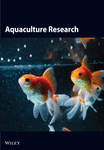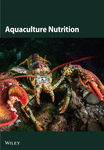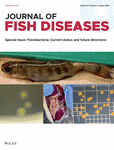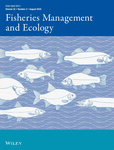Aquaculture, Fish and Fisheries
Author Guidelines
Once the submission materials have been prepared in accordance with the Author Guidelines, manuscripts should be submitted online at https://wiley.atyponrex.com/journal/AFF2.
For help with submissions, please contact: [email protected]
This journal does not charge submission fees.
Article Preparation Support
Wiley Editing Services offers expert help with English Language Editing, as well as translation, manuscript formatting, figure illustration, figure formatting, and graphical abstract design – so you can submit your manuscript with confidence.
Also, check out our resources for Preparing Your Article for general guidance about writing and preparing your manuscript.
Free format submission
Aquaculture, Fish and Fisheries now offers Free Format submission for a simplified and streamlined submission process.
Before you submit, you will need:
- Your manuscript: this should be an editable file including text, figures, and tables, or separate files — whichever you prefer. Whilst we are supportive of free formatting, we recommend not including line numbers on a submitted paper. These are automatically generated upon submission and so inclusion of these can lead to inconsistencies in numbers. Required sections should be contained in your manuscript, including abstract, introduction, methods, results, discussion and conclusions (optional). Figures and tables should have legends. Figures should be uploaded in the highest resolution possible. If the figures are not of sufficiently high quality your manuscript may be delayed. References may be submitted in any style or format, as long as it is consistent throughout the manuscript. Supporting information should be submitted in separate files. If the manuscript, figures or tables are difficult for you to read, they will also be difficult for the editors and reviewers, and the editorial office will send it back to you for revision. Your manuscript may also be sent back to you for revision if the quality of English language is poor.
- An ORCID ID, freely available at https://orcid.org. (Why is this important? Your article, if accepted and published, will be attached to your ORCID profile. Institutions and funders are increasingly requiring authors to have ORCID IDs.)
- A cover letter — this should concisely introduce your work to the editor as well being an opportunity to communicate why the manuscript will be of interest to the journal's readers and its contribution to the overall field.
- The title page of the manuscript, including:
- Your co-author details, including affiliation and email address. (Why is this important? We need to keep all co-authors informed of the outcome of the peer review process.)
- Statements relating to our ethics and integrity policies, which may include any of the following (Why are these important? We need to uphold rigorous ethical standards for the research we consider for publication):
- data availability statement (required, with the exception of editorials);
- funding statement;
- declaration of conflicts of interest, or absence of (required, with the exception of editorials);
- ethics approval statement;
- patient consent statement;
- permission to reproduce material from other sources;
- clinical trial registration.
To submit, log in at https://wiley.atyponrex.com/journal/AFF2 and create a new submission. Follow the submission steps as required and submit the manuscript.
Open Access
Preprint policy:
Please find the Wiley preprint policy here.
This journal accepts articles previously published on preprint servers.
Aquaculture, Fish and Fisheries will consider for review articles previously available as preprints. You are requested to update any pre-publication versions with a link to the final published article. You may also post the final published version of the article immediately after publication.
Data Sharing and Data Availability
This journal expects data sharing. Review Wiley’s Data Sharing policy where you will be able to see and select the data availability statement that is right for your submission. Please note that Editorials are exempt.
Refer and Transfer Program
Wiley believes that no valuable research should go unshared. This journal participates in Wiley’s Refer & Transfer program. If your manuscript is not accepted, you may receive a recommendation to transfer your manuscript to another suitable Wiley journal, either through a referral from the journal’s editor or through our Transfer Desk Assistant.
Data Citation
Please review Wiley’s Data Citation policy.
Data Protection
By submitting a manuscript to or reviewing for this publication, your name, email address, and affiliation, and other contact details the publication might require, will be used for the regular operations of the publication. Please review Wiley’s Data Protection Policy to learn more.
Funding
You should list all funding sources in the Acknowledgments section. You are responsible for the accuracy of their funder designation. If in doubt, please check the Open Funder Registry for the correct nomenclature.
Authorship
All listed authors should have contributed to the manuscript substantially and have agreed to the final submitted version. Review editorial standards and scroll down for a description of authorship criteria.
Artificial Intelligence Generated Content
Please find Wiley’s policy on Artificial Intelligence Generated Content (AIGC) here.
In accordance with COPE’s position statement on AI tools, AIGC tools cannot fulfill the role of, nor be listed as, an author of an article. If an author has used this kind of tool to develop any portion of a manuscript, its use must be described, transparently and in detail, in the Methods or Acknowledgements section. The author is fully responsible for the accuracy of any information provided by the tool and for correctly referencing any supporting work on which that information depends. Tools that are used to improve spelling, grammar, and general editing are not included in the scope of these guidelines. If there is any doubt as to whether the use of such tools must be reported, please contact the Editorial Office at AFFoffice.
ORCID
This journal requires ORCID. Please refer to Wiley’s resources on ORCID.
Reproduction of Copyright Material
If excerpts from copyrighted works owned by third parties are included, credit must be shown in the contribution. It is your responsibility to also obtain written permission for reproduction from the copyright owners. For more information visit Wiley’s Copyright Terms & Conditions FAQ.
The corresponding author is responsible for obtaining written permission to reproduce the material "in print and other media" from the publisher of the original source, and for supplying Wiley with that permission upon submission.
Title Page
The title page should contain:
- A brief informative title containing the major key words. The title should not contain abbreviations (see Wiley's best practice SEO tips);
- A short running title of less than 40 characters;
- The full names of the authors;
- The author's institutional affiliations where the work was conducted, with a footnote for the author’s present address if different from where the work was conducted;
- Acknowledgments.
Main Text File
The main text file should be in Word or PDF format and include:
Manuscripts can be uploaded either as a single document (containing the main text, tables and figures), or with figures and tables provided as separate files. Should your manuscript reach revision stage, figures and tables must be provided as separate files. The main manuscript file can be submitted in Microsoft Word (.doc or .docx format).
Your main document file should include:
- A short informative title containing the major key words. The title should not contain abbreviations
- The full names of the authors with institutional affiliations where the work was conducted, with a footnote for the author’s present address if different from where the work was conducted;
- Acknowledgments;
- Abstract unstructured
- Up to seven keywords;
- Main body: formatting is flexible and dependent on article type (see further information below). We suggest including introduction, materials & methods, results, discussion, conclusion (optional) as a tentative guide.
- References;
- Tables (each table complete with title and footnotes);
- Figure legends: Legends should be supplied as a complete list in the text. Figures should be uploaded as separate files (see below).
- Please note that authors do not need to provide line numbers as these will be automatically generated upon submission.
Reference Style
This journal uses Harvard reference style; as the journal offers Free Format submission, however, this is for information only and you do not need to format the references in your article. This will instead be taken care of by the typesetter.
Figures and Supporting Information
Figures, supporting information, and appendices should be supplied as separate files. You should review the basic figure requirements for manuscripts for peer review, as well as the more detailed post-acceptance figure requirements. View Wiley’s FAQs on supporting information.
Graphical Abstract (optional)
The journal’s abstract can be presented in graphical form with a brief abstract.
The table of contents entry must include the article title, the authors' names (with the corresponding author indicated by an asterisk), no more than 80 words or 3 sentences of text summarizing the key findings presented in the paper and a figure that best represents the scope of the paper.
Table of contents entries should be submitted as ‘Supplementary material for review’ during the initial manuscript submission process.
The image supplied should fit within the dimensions of 50mm x 60mm and be fully legible at this size.
Translated Abstract (optional)
All submissions must be written in English. However, we encourage authors to provide a second abstract in their first language or the language relevant to the country in which the research was conducted. The second abstract will be published with the online version of the article and will not be included in the PDF. Please note that second abstracts will not be copyedited and will be published as provided by the authors, who take responsibility for the accuracy of the translation. Authors who wish to take advantage of this option should include their second abstract alongside their submission, selecting the file type “Translated Abstract Not for Review.
Peer Review
Transparent Peer Review: This journal is participating in a pilot on Peer Review Transparency. By submitting to this journal, authors agree that the reviewer reports, their responses, and the editor’s decision letter will be linked from the published article to where they appear on Publons in the case that the article is accepted. Authors have the opportunity to opt out during submission, and reviewers may remain anonymous unless they would like to sign their report.
This journal operates under a single-blind peer review model. Papers will only be sent to review if the Editor-in-Chief determines that the paper meets the appropriate quality and relevance requirements.
In-house submissions, i.e. papers authored by Editors or Editorial Board members of the title, will be sent to Editors unaffiliated with the author or institution and monitored carefully to ensure there is no peer review bias.
Wiley's policy on the confidentiality of the review process is available here.
This journal participates in Wiley’s Transfer Desk Assistant program.
Guidelines on Publishing and Research Ethics in Journal Articles
The journal requires that you include in the manuscript details IRB approvals, ethical treatment of human and animal research participants, and gathering of informed consent, as appropriate. All authors must declare all conflicts of interest, or none, on submission. Please review Wiley’s policies surrounding human studies, animal studies, clinical trial registration, biosecurity, and research reporting guidelines.
This journal follows the core practices of the Committee on Publication Ethics (COPE) and handles cases of research and publication misconduct accordingly (https://publicationethics.org/core-practices).
This journal uses iThenticate’s CrossCheck software to detect instances of overlapping and similar text in submitted manuscripts. Read Wiley’s Top 10 Publishing Ethics Tips for Authors and Wiley’s Publication Ethics Guidelines.
Author Contributions
For all articles, the journal mandates the CRediT (Contribution Roles Taxonomy)—more information is available on our Author Services site.
Author Name Change Policy
In cases where authors wish to change their name following publication, Wiley will update and republish the paper and redeliver the updated metadata to indexing services. Our editorial and production teams will use discretion in recognizing that name changes may be of a sensitive and private nature for various reasons including (but not limited to) alignment with gender identity, or as a result of marriage, divorce, or religious conversion. Accordingly, to protect the author’s privacy, we will not publish a correction notice to the paper, and we will not notify co-authors of the change. Authors should contact the journal’s Editorial Office with their name change request.
Correction to authorship
In accordance with Wiley’s Best Practice Guidelines on Research Integrity and Publishing Ethics and the Committee on Publication Ethics’ guidance, Aquaculture, Fish and Fisheries will allow authors to correct authorship on a submitted, accepted, or published article if a valid reason exists to do so. All authors – including those to be added or removed – must agree to any proposed change. To request a change to the author list, please complete the Request for Changes to a Journal Article Author List Form and contact either the journal’s editorial or production office, depending on the status of the article. Authorship changes will not be considered without a fully completed Author Change form. (Correcting the authorship is different from changing an author’s name; the relevant policy for that can be found in Wiley’s Best Practice Guidelines under “Author name changes after publication.”)
Original Articles
Description: Generally, original articles are based upon hypothesis-driven research describing a single study or several related studies constituting a single project. Descriptive studies are allowed providing that they include scholarly insight that contributes to advancement of the state of information on a given scientific topic.
Word Limit: The recommended limit is 12,000 words (excl. references). If you do need to exceed this amount, please justify why in your cover letter.
Review Articles
Description: Reviews should define the present level of understanding of their subject and suggest new insights or possible avenues for future investigation.
Word Limit: max 25,000 (excl. references)
Underwater Notes
Description: Underwater Notes should be detailed in a short format thought-provoking, significant, preliminary studies, experimental procedures, new technologies/systems, or applied activities within laboratories or in the field, including but not limited to case studies, observational studies and confirmatory reports that may include more descriptive and opportunistic observations that may not adhere to the usual standard of research articles. We are not simply looking for documentation of first occurrences of aquatic plants and animals, validation studies or corroborative reports.
Underwater Notes articles will be subject to the same standards of peer review and data accessibility as our other categories. For further information please see the dedicated editorial.
Word Limit: The maximum limit is 6,000 words (excl. references), however, we encourage shorter format as described above.
Viewpoints
Description: These are concise pieces that focus on key challenges, issues, or recent developments. They can be opinion-style articles presenting the author’s perspective on a specific issue or conceptual advances that convey new ideas or controversial viewpoints on cutting-edge topics. Viewpoints may provide a personal opinion on a topic, using a novel or imaginative approach to explore provocative questions. They engage readers through rigorous investigation, enhancing the understanding of the subject, including new developments using at least a regional scale or covering a discipline framed within the scope of the journal.
Word Limit: max 5,000 (excl. references) and 5 figures.
Correspondence and Reply
Description: A Correspondence is a short letter responding to an article previously published in the journal. The authors of the original article will be invited to submit a Reply. Both the Correspondence and Reply will be considered together, and if accepted, published simultaneously.
Word limit: Max. 500 (excl. references)
*Editorials may be submitted by invitation only. This article type is exempt from Data Availability Statement and Conflict of Interest statement requirements.
First Look
After your paper is accepted, your files will be assessed by the editorial office to ensure they are ready for production. You may be contacted if any updates or final files are required. Otherwise, your paper will be sent to the production team.
Wiley Author Services
When an accepted article is received by Wiley’s production team, the corresponding author will receive an email asking them to login or register with Wiley Author Services. You will be asked to sign a publication license at this point as well as pay for any applicable APCs. For more information about this journal's APC's, please visit the Open Access Page.
Cover Image Submissions
This journal accepts artwork submissions for Cover Images. This is an optional service you can use to help increase article exposure and showcase your research. For more information, including artwork guidelines, pricing, and submission details, please visit the Journal Cover Image page.
Copyright & Licensing
Aquaculture, Fish and Fisheries is an Open Access journal: authors of accepted papers pay an Article Publication Charge and their papers are published under a Creative Commons license. This journal uses the CC-BY Creative Commons License. Note that certain funders mandate a particular type of CC license be used.
Proofs
Authors will receive an e-mail notification with a link and instructions for accessing HTML page proofs online. Authors should also make sure that any renumbered tables, figures, or references match text citations and that figure legends correspond with text citations and actual figures. Proofs must be returned within 48 hours of receipt of the email.
Continuous Publication
Under a Continuous Publication model used at Wiley, journal articles are published directly into an online issue with their final citations as soon as they are ready. There is no issue curation and no issue pagination; articles publish when they have completed production and are not held for upcoming issues. The ability to publish an article online before its issue is completed provides faster publishing of articles with final citation details for the academic community.
Article Promotion Support
Wiley Editing Services offers professional video, design, and writing services to create shareable video abstracts, infographics, conference posters, lay summaries, and research news stories for your research – so you can help your research get the attention it deserves.









